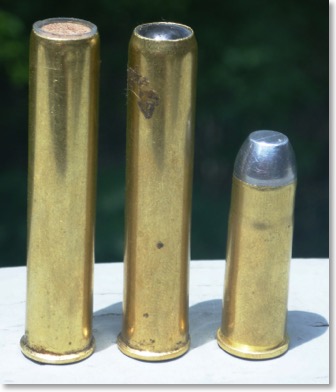
Ed Harris: How to Make and Load All-Brass .410 Shotshells.
How to Make and Load All-Brass .410 Shotshells
by C.E. “Ed” Harris
I thought a brief how-to-do-it on loading all-brass .410s would be helpful. I’ve successfully done some of this, years ago fire-forming from .303 British, as well as 9.3x74R German and more recently using Magtech .410 all-brass shells from Midway, which is MUCH easier. Load data, wads and assembly/crimping technique are a bit different from using modern plastic shells and wads.
In break-open shotguns, all-brass cases can be made easily by fire-forming from .303 British brass, which is still cheap and plentiful. Charge the case with ten grains of any fast-burning pistol or shotshell powder you have handy. Almost anything you have will work. Push a cotton ball or wadded up square of TP down firmly onto the powder, fill the case to the shoulder with Cream of Wheat, then press a Gulf wax plug into the case mouth. Fire-form the case, pointing the muzzle straight up. The resulting case is 2.25″ in length. Cases should fire-form perfectly without splits on the first pop if they are either new, unfired, or have been mouth annealed first. Old .303 cases which have been reloaded as rifle rounds several times absolutely must be annealed first!
(A quickie on how to anneal rifle brass which works for this application: https://www.youtube.com/watch?v=MVeRDAsrCfM)
With Magtech 2-1/2” brass use 15.4 grains of #2400 powder, a Buffalo Arms .44 vegetable fiber 1/16” card over the powder, then two Buffalo Arms .44-45 wool felt cushion wads , LIGHTLY oiling the top cushion wad only, applying TWO DROPS of 30 weight motor oil with an eye dropper, squishing the wad between the fingers a few times to work it in, then wrapping the wad in a square of TP, squeezing it again between the thumb and forefinger to wick out and absorb any excess oil. This greatly reduces leading if you load birdshot directly, without using the Federal No.410SC shot cup.
A .45 Schofield case holds about half an ounce of lead shot, if you want to make a dip-cup . Fill the case to within 1/8” of the case mouth with fine shot, 7-1/2 or smaller. Insert another 1/16” card as an overshot wad, and glue in place with Elmer’s Glue. You more shot in the case by using the old fashioned card and fiber wad column, but my cylinder-bore gun throws better patterns using the Federal No.410SC (1/2 oz. Skeet) shot cup over the card, pouring the shot into that and closing the shell by crimping (or gluing with Elmer’s) a .36 cal. card inside the top of the shot cup, as shown in the photo.
If you have a Lee .38-56 Winchester seater die, you can make a finished-looking crimp by inserting a blank Lyman 450 sizer top punch into the seater die plug, adjusting the seating stem to position the top card, (use a .44 cal. to fit the all-brass shell, or a .36 cal. to fit inside the Federal shot cup when using that one). You want the overshot card slightly below the case mouth, as you bump the case mouth against the die shoulder to form a nicely rounded, professional-looking crimp.
To load buckshot, charge powder in the primed case, insert a card firmly over the powder, as you did before. Use a Federal No.410SC plastic shot cup to contain and center the buckshot. It is absolutely necessary to use an over-powder card under the Federal plastic shot cup in brass cases, because the wad diameter is too small to seal the case interior. Omitting the card results in powder leaking past the wad, causing “bloopers.” After firmly seating the Federal No.410SC plastic wad column against the over-powder card, drop four 00 buckshot into the shot cup, then add one SOFT cast ..395”roundball on top of the stack. Adjust the .38-56 seater so the top ball is crimped neatly, but positively in the end of the shell.
The 1951 Ideal Handbook provides data with #2400 powder for .410 shells with conventional wad columns, which is appropriate. It also suggests thickness of the filler wad(s) should be not less than 1/2 bore diameter and not more than bore diameter. Minimum filler wad thickness in the 410 bore is 0.205 inches. A .444 Marlin sizer die with Lee No.5 shell holder can be used to resize brass cases if necessary. Prime cases with large pistol primers. The RCBS Little Dandy Rotors #19 measures the appropriate charge of Alliant #2400. Thumb an over powder card into case mouth and slide firmly onto the powder using a dowel. Similarly seat the filler wad(s), or plastic shot cup, if used. Add shot and top card or buckshot. Glue top card or crimp, if a suitable die is available. That’s all there is to it.
(The opening picture shows features two all-brass .410s, one with birdshot, another with buckshot, with .44-40 cartridge for comparison.)
- Posted by Grant Cunningham
- On July 21, 2014


